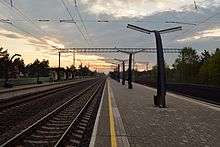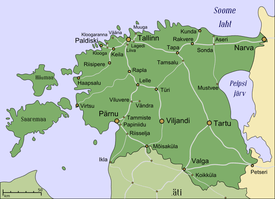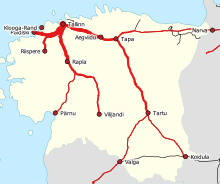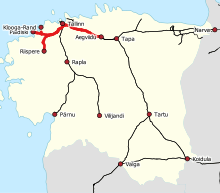Rail transport in Estonia
The rail transport system in Estonia consists of about 1,200 kilometres (750 mi) of railway lines, of which 900 kilometres (560 mi) are currently in public use. The infrastructure of the railway network is mostly owned by the state and is regulated and surveyed by the Estonian Technical Surveillance Authority (Estonian: Tehnilise Järelevalve Amet).
All public railways in Estonia are 1,520 mm (4 ft 11 27⁄32 in) (Russian gauge), the same as in Russia, Belarus, Latvia, and Lithuania. The 1,520 mm gauge used in Estonia is also compatible with Finland's 1,524 mm (5 ft) gauge. Sometimes it is defined to be 1,524 mm (see Rail gauge in Estonia), for example when buying track maintenance or vehicles from Finland.
Railways in Estonia today are used mostly for freight transport, but also for passenger traffic, with 7.3 million passengers reported in 2017.[1] Passenger transport is most frequent near Tallinn, centred on the main Balti jaam.
History
Network

- Total length: circa 1,200 km, of which 900 km in public use[2]
- Gauge: 1,520 mm (4 ft 11 27⁄32 in) Russian gauge
- Electrified: 133 km (83 mi).
The Estonian railway network is owned by the state-owned company AS Eesti Raudtee and the private company Edelaraudtee Infrastruktuuri AS. These railway network infrastructure operators provide all railway network services for railway operators running freight and passenger services. AS Eesti Raudtee provides approximately 800 kilometres (500 mi) of track, of which 107 kilometres (66 mi) is double track and 133 kilometres (83 mi) is electrified. Edelaraudtee Infrastruktuuri AS maintains 298 kilometres (185 mi) of track which consists of 219 kilometres (136 mi) of main line and 79 kilometres (49 mi) of station line.
Main lines




Owned by AS Eesti Raudtee:
- Tallinn–Narva railway, 209.6 km (130.2 mi). This line was completed in 1870. It was originally a part of the railway network of the Russian Empire, connecting Paldiski to St. Petersburg via Tallinn and Narva.
Passenger trains are operated by Elron (Tallinn–Aegviidu, Tallinn–Tartu, Tallinn–Rakvere and Tallinn–Narva routes) and by GO Rail (international trains to Moscow and St. Petersburg, Russia). - Tallinn–Keila–Paldiski, 47.7 km (29.6 mi). Passenger trains are operated by Elron (Tallinn–Pääsküla, Tallinn–Keila, Tallinn–Paldiski and Tallinn–Klooga-rand routes).
- Keila–Riisipere, 24.4 km (15.2 mi). This line is part of the former Keila–Haapsalu line, that was completed in 1905. The Riisipere–Haapsalu section was abandoned in 2004[3], but is due to be rebuilt as far as Turba during 2019, as a first step towards eventually re-opening the line to Haapsalu (and possibly the port at Rohuküla ) [4]. Passenger trains are operated by Elron (Tallinn–Riisipere route).
- Tapa–Tartu, 112.5 km (69.9 mi). Completed in 1877.[5]
Passenger trains are operated by Elron (Tallinn–Tartu and Tartu–Jõgeva routes). - Tartu–Valga, 82.5 km. Completed in 1887.[5] International connection from Valga in Estonia to Valka in Latvia.
Passenger trains between Tartu and Valga are operated by Elron. Passenger trains between Valga and Riga are operated by Latvian Railways. - Tartu–Pechory, 83.5 km (51.9 mi). Built between 1929 and 1931. International connection from Koidula railway station (Koidula) in Estonia to Pechory in Russia.
Passenger trains are operated by Elron (Tartu–Koidula route). - Valga–Pechory, 91.5 km (56.9 mi). Part of Riga–Pskov railway, opened to regular traffic in 1889.[5] International connection from Koidula railway station in Estonia to Pechory in Russia.
The line is used only by freight trains.
Owned by Edelaraudtee Infrastruktuuri AS:
- Tallinn–Lelle–(Pärnu)–(Mõisaküla), 141.4 km (87.9 mi) (formerly 190.0 km). There was an international connection from Mõisaküla to Latvia, but the stretch Pärnu–Mõisaküla was abandoned in 2008.[6][7] The Lelle-Pärnu section was permanently closed for passenger operations on 9 December 2018 as it required a €17 million refurbishment. A rail service to Pärnu station will be resumed with the opening of the Rail Baltica line.[8][9]
- Lelle–Viljandi, 78.7 km (48.9 mi). This line connects Viljandi to the Tallinn–Pärnu line via Lelle.
Major industrial railways
- Põlevkivi Raudtee (oil shale railway) maintains over 200 km (120 mi) of track in Ida-Virumaa.[10] Main use of the network is transporting oil shale from underground and open-cast mines to the Narva Power Plants. The company is a subsidiary of Eesti Põlevkivi, which itself is a subsidiary of Eesti Energia, owned by the state.
- Rakvere–Kunda, 19 km (12 mi). Built in 1896,[11] this line connects the industrial town of Kunda to the Tallinn–Tapa–Narva line. The line is owned by private company Kunda Trans.
Connections to adjacent countries
Daily passenger service connect Tallinn with Moscow (night train; travel time is 15 hours) through Saint Petersburg, operated by the Russian Railways.
As of summer 2016 three daily trains operated by Latvian Railways connect Riga (Latvia) to Valga (Estonia). The other railway lines to neighbouring countries are not used for direct passenger traffic at the moment. It is possible to travel between Tallinn and Riga with train change at Valga, and the timetables of Tallinn–Valga and Valga–Riga are adjusted for that purpose, but this still takes a long time compared to bus (travel time about 5 hours) or air.
Historic train routes are Tallinn–Moscow via Tartu–Pechory, and Riga–St. Petersburg, which passed through Estonia from Valka, Latvia to Valga, Estonia–Võru–Piusa–Pechory, Russia. Both were closed in the 1990s.
There are plans for a new high-speed line Tallinn–Riga (continuing to Poland), Rail Baltica, planned to be in operation around 2025.
Operators
Freight trains are operated by Eesti Raudtee and private companies including Estonian Railway Services (E.R.S. AS),[12] and Spacecom.[13]
Passenger services are offered by three operators:
- Elron, domestic routes
- Russian Railways, Tallinn–Saint Petersburg and Tallinn–Moscow
- Pasažieru vilciens, Valga–Riga
See also
- Narrow gauge railways in Estonia
- Rail Baltica
- Rail transport by country
- Transport in Estonia
References
- "Estonian Railways passenger numbers, transported cargo volumes up in 2018". err.ee. 15 March 2018. Retrieved 18 January 2020.
- "Estonian Technical Surveillance Authority". Retrieved 2008-12-09.
- "Eesti Raudteemuuseum" (in Estonian). Archived from the original on 2009-09-07. Retrieved 2008-12-09.
- "Go Track to build Riisipere - Turba railway" (in Ewe). Retrieved 2018-12-30.
- "About Estonian Railways: Corporate information: History". Eesti Raudtee. Retrieved 2008-12-10.
- Tanel Mazur (2007-07-16). "Mõisaküla: viimane sõit raudteed pidi Pärnusse" (in Estonian). Eesti Päevaleht. Retrieved 2007-08-11.
- Tõnu Kann (2008-11-08). "Koos Pärnu-Mõisaküla raudteega hääbub elu ja sureb linn" (in Estonian). Pärnu Postimees. Archived from the original on 2009-09-09. Retrieved 2008-11-13.
- "Estonia to close railway line and wait for Rail Baltica". Baltic News Network. 6 November 2018.
- ERR News. Tallinn-Pärnu railway line to be closed permanently in December. Retrieved 7 June 2019
- "Eesti Põlevkivi: Raudteetransport" (in Estonian). Archived from the original on 2009-09-07. Retrieved 2008-12-10.
- "138 years of cement". Retrieved 2008-12-10.
- E.R.S. about us Archived 2011-07-20 at the Wayback Machine www.ers.com.ee
- The Joint Stock Company Spacecom Archived 2010-03-07 at the Wayback Machine www.spacecom.ee
External links
| Wikimedia Commons has media related to Rail transport in Estonia. |
- Division of railways at Estonian Technical Surveillance Authority — Web pages containing various statistical information about the railway network and operations in Estonia.
- Map of public railways and railway stations
- National railway company Eesti Raudtee
- Estonian Railway Museum in Haapsalu (history page) (in Estonian)
- Estonian private Railway Company "GoRail" official website (in Russian and Estonian)
- Estonia: End of the line for Europe's passenger rail network